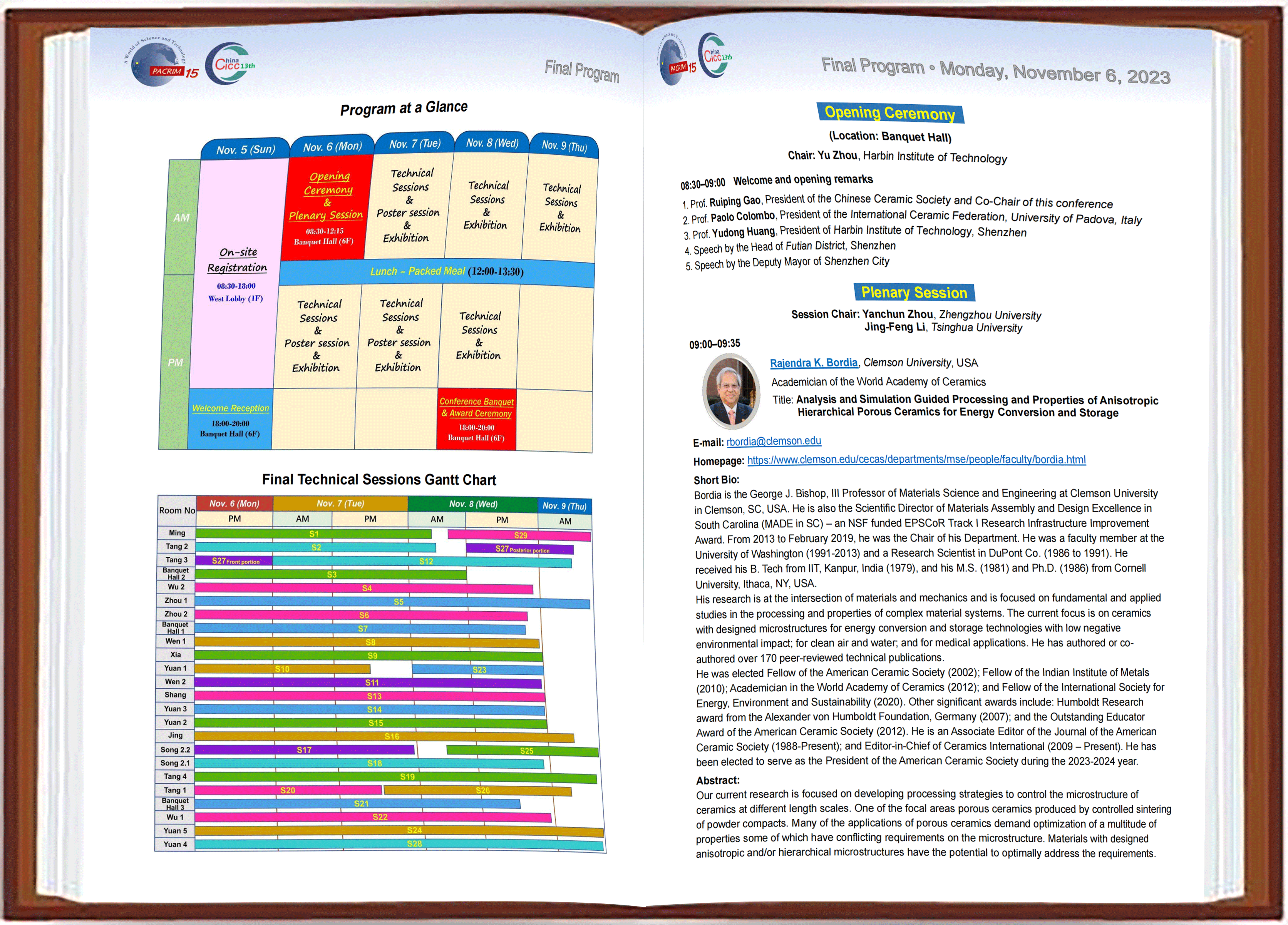Home >Symposium

- Registration is NOW OPEN! The early-bird deadline is Sep. 30, 2023. Please don't miss out on the early registration rate! Aug. 21, 2023
- Abstract Submission has been extended to Aug. 15, 2023! Take advantage of the LAST OPPORTUNITY to submit and present your research at the PACRIM15 & CICC-13!
- 3rd announcement-call for abstracts (full-text version)
- 3rd announcement-call for abstracts (short version)
- 2nd announcement-revised version
Venue & address
Contact us
Symposium 17
Materials for Advanced Nuclear Energy Systems and Nuclear Waste Management
The next generation nuclear energy, including fission & fusion energy systems, plays a crucial role in the development of a sustainable and low-carbon society. Many of the critical structural components inside a next generation nuclear energy system will be subjected to a harsh application environment including high temperature, high energy and high flux neutron radiation, and chemical corrosion by coolants, which likely impose a grand challenge for most incumbent metallic materials. Advanced materials based on inorganic nonmetallic materials are expected to provide a range of material solutions for achieving higher fuel burning rate and efficiency, improved economic benefits, an inherently safe reactor with long-term stability, and immobilization of radiation nuclear wastes. Currently, the incorporation of advanced ceramics would allow engineers to design a nuclear fuel system that would be more accident tolerant during the loss of cooling system as compared to the UO2-Zircalloy system currently employed for light water and pressurized water reactors. Fine-grained graphite and ceramic-based composites have been widely considered for structural components in various high temperature reactors (HTR). On the other hand, advanced ceramic materials could have the potential to advance radiation detection and secure waste immobilization technologies. Therefore, the aim of this symposium is to provide an open forum for materials scientists and nuclear engineers from around the world to share their up-to-date progress and exchange views on the development of various advanced materials for next generation nuclear energy and application experiences of these materials in design of reactors, fuels, and waste treatment.
Proposed sessions
| ª | Advanced ceramics, ceramic composites and graphite materials for advanced fission and fusion nuclear energy systems |
| ª | Radiation effects and damages on microstructure and mechanical properties |
| ª | Materials and their behaviours under the accidental conditions |
| ª | Next generation accident-tolerant fuels |
| ª | Molten salt, lead, or supercritical water corrosion |
| ª | Computer simulation of radiation effect, materials modelling, and database |
| ª | Ceramics and glass for nuclear waste management |
Organizers
| - | Guo-Jun Zhang (Points of Contact), Donghua University,China, gjzhang@dhu.edu.cn |
| - | Yutai Katoh (Points of Contact), Oak Ridge National Laboratory, USA, katohy@ronl.gov |
| - | Ji-Yeon Park (Points of Contact)Korea Atomic Energy Research Institute, Korea, jypark@kaeri.re.kr |
| - | Hua-Tay Lin, Guangdong University of Technology, China |
| - | Young-Wook Kim, University of Seoul, Korea |
| - | Houzheng Wu, SIAMC Advanced Material Corporation, China |
| - | Yingjie Zhang, Australian Nuclear Science and Technology Organization, Australia |
| - | Libin Sun, Tsinghua University, China |
| - | Hans J. Seifert, Karlsruhe Institute of Technology, Germany |
| - | Jia-Xiang Xue, China Nuclear Power Technology Research Institute Co., Ltd., China |
| - | Tatsuya Hinoki, Kyoto University, Japan |
| - | Monica Ferraris, Politecnico di Torino, Italy |
| - | Ping Xiao, The University of Manchester, UK |
| - | Haibin Zhang, Shanghai Jiao Tong University, China |
| - | Weichao Bao, Shanghai Institute of Ceramics, Chinese Academy of Science, China |
Keynote Speakers

|
|
|||||||
|
Engineering of Korea Advanced Institute of Science and Technology (KAIST) since 2013. He has published 153 international journal papers and holds 66 patents in the area of nuclear fuel, radioactive waste forms, metal and ceramic matrix composites, oxide dispersion strengthened alloys, nanocomposites, high entropy alloys and refractory materials. Currently, Prof. Ryu is the Head of the Nuclear Fuel Materials Laboratory of KAIST. Prior to his joining KAIST as a faculty member of the Department of Nuclear and Quantum Engineering in 2013, Dr. Ryu had worked as a senior and principal researcher at the Korea Atomic Energy Research Institute (KAERI) for 13 years. He participated in research projects on advanced materials and processing technologies for nuclear fuel, the nuclear fuel cycle, and medical radioisotope production. While at KAERI, he was a visiting scholar at Argonne National Laboratory (ANL, IL, USA, 2005-2007), and International Atomic Energy Agency (IAEA, Vienna, Austria, 2009-2011). He received a B.S., M.S., and Ph.D. in materials science and engineering from KAIST.
|
||||||||

|
|
|||||||
|
Materials Engineering at Institute of Materials Research (IMR), Tohoku University since 2018. He also teaches material science at the Department of Quantum Science and Energy Engineering of Tohoku University. Previously, he held positions as Program Specific Associate Professor (2017-2014) and Assistant Professor (2009-2014) at Institute of Advanced Energy, Kyoto University and as Postdoctoral fellow (2006-2009) under the Postdoctoral Research Associates Program in the Oak Ridge National Laboratory (ORNL). He received his Ph.D. in energy science from the Kyoto University in 2006. He has published a number of journal articles on the irradiation effects of silicon carbide (SiC) since 2002 and frequently provides invited lectures and talks on that at the international conferences related to nuclear materials. Much of his recent work has focused on irradiation effects on the hydrothermal corrosion of SiC, in particular why the corrosion reaction is accelerated under irradiation and how to protect the surface. As one solution, he is representing a project of the MEXT of Japan (2020-2024), where he is developing ceramic coatings.
|
||||||||
Invited Speakers

|
|
||||

|
|
||||

|
|
||||

|
|
||||

|
|
||||

|
|
||||

|
|
||||

|
|
||||

|
|
||||

|
|
||||

